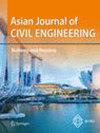IoT based structural health monitoring of bridges using wireless sensor networks
Abstract
This work intends to demonstrate the importance of deployment of structural health monitoring (SHM) systems for monitoring real-time detection of damages or defects in structural components and forecast the outstanding life of bridge structures. The main objective is to focus on designing an optimized sensor network and implementation to SHM of bridges. Adopting an optimum number and appropriate location of sensors is of utmost importance for integration of SHM systems that influence the accuracy of assessment, system performance and the total cost. A computational framework is developed in Python which provides optimal configurations for sensors and actuators to be deployed with ultrasonic guided-waves for non-destructive testing of bridges in service. An objective function is developed for convex entropy with the goal of decreasing uncertainty while optimising the monitoring system’s expected accuracy in locating structural degradation. The framework is designed to deal with two types of materials: isotropic and anisotropic composite materials. Two plates made of composite material and aluminium metal are used to show the usefulness and efficiency of the current framework. The best actuator and sensor configurations for the ultrasonic guided wave based use in bridges have been discovered. It is observed that for the composite plate, the current function value is 94.71597173 and for the metal plate it is 55.6033447. Finally, in the future the authors will validate the results obtained from the present framework with that of the experimental work using the equipment to be delivered by BeanAir-Germany.

 求助内容:
求助内容: 应助结果提醒方式:
应助结果提醒方式:


